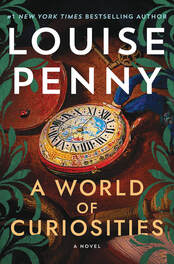
Avid Louise Penny fans are basking in the afterglow of her new novel, “A World of Curiosities,” the prolific author’s 18th entry in her Armand Gamache series. The book debuted at the end of November and immediately jumped to the No. 1 spot on bestseller lists. If you haven’t read it yet, get in line, because it is a winner!
I would never want to spoil the book for a reader, so this review is missing many important details of the story. But I can attest to the fact that it is a terrific book, rich in motivations, insights, and, above all, mystery.
“A World of Curiosities” is set primarily in Three Pines, the fictional village in the Eastern Provinces of Canada where Chief Inspector Armand Gamache and his wife, Reine-Marie, live. As head of the homicide department of the Sûreté du Quebec, this most empathetic policeman is, as always, the main character in this drama by the award-winning writer. Characters, in addition to the Gamaches, include his right-hand assistant Jean-Guy Beauvoir, and villagers Ruth, Myrna, Clara, Gabri, and Olivier, beloved by and familiar to Penny fans.
The book opens with a bleak scene where Gamache and Jean-Guy are recovering from a remote lake the body of a young woman who had been reported missing. When the officers go to tell the woman’s children, daughter Fiona and son Sam, what happened to their mother, the events of the novel are set in motion. And thus begins the spiraling tale of vengeance and violence, though the denouement takes many years to be realized.
Penny is well known for including quotes from poems in her novels, usually ones written by Margaret Atwood and fictionally attributed to her character Ruth Zardo. In “A World of Curiosities,” she borrows the following chilling stanza from one of W.H. Auden’s poems:
“Behind the corpse in the reservoir, behind the ghost on the links,
Behind the lady who dances and the man who madly drinks,
Under the look of fatigue, the attack of migraine and the sigh.
There is always another story, there is more than meets the eye.”
The last line in the above quote, is repeated throughout the book and epitomizes the overwhelming tension with its distinct foreboding.
The title of the book refers to an artwork that Gamache and the villagers uncover in a walled-up section of Myrna’s attic. Itself a “world of curiosities,” it is modeled on the Paston Treasure, a real painting completed in 1600’s England. You can look up the original still life and see the somewhat fiendish and cluttered design that it presents of various collectibles as well as persons and animals, not necessarily in their real sizes. “There is more than meets the eye” is particularly appropriate,
Another interesting facet of the book is its plot line that concerns the true-life tragedy known in Canada as the Montreal Massacre. In 1989 a crazed gunman attacked a group of female students at the Ecole Polytechnique, an engineering school, killing 14 and injuring 10 more, claiming to kill them because they were feminists. Penny herself was a young reporter and covered the event. One of the survivors of the attack, Nathalie Provost, actually plays a role in the book.
Penny uses this historical event to subtly address the need for stricter gun control laws, a cause she has also supported in earlier novels. Hers is a compelling argument, and her not-so-hidden message is a notable counterpoint to the many cryptic and foreshadowing messages found in the painting from the attic.
The action in the book whirls around Sam and Fiona, damaged beyond belief by their early life. Fiona was sponsored by Gamache, who, believing her to be salvageable, had helped her obtain a degree in engineering. But Sam has never won Gamache’s trust. When the two, now grown, arrive in Three Pines, Gamache and Jean-Guy know there is something afoot, and set out to discover their motivation.
Penny is a master in creating an atmosphere of steadily growing dread. The tension in the book is quite palpable, making a reader rush through, propelled by the need to solve the mystery. I consumed it over two days when it was first released, but when I was preparing to write this review, I decided to revisit some scenes. Alas, I was unable, again, to put the book down and reread every word. It is that compelling!
Note: If you just can’t get enough of Louise Penny, and I definitely can’t, be sure to check out “Three Pines,” the eight-part television series on Amazon Prime.
Before I watched the production, I made a decision that I would not let seeing it change my own vision for any of the characters or scenery of the books. After all, I had already pictured my own Gamache (Roger Allam), Jean-Guy (Wilmer Valderrama) and Ruth (Cloris Leachman) and didn’t want to give them up. And I know from experience that it’s easy to let the movie supplant the book, which is only in the mind’s eye.
I watched “Three Pines” as if I had never heard of it and enjoyed every minute. I found it to be like watching a foreign film since the only actor with whom I was familiar was Alfred Molina, who is terrific as Gamache. The story is somewhat different since it includes a theme not in the books, but that just made it more fascinating.
So, if you have some extra time on one of our dreary winter days, binge on!
I would never want to spoil the book for a reader, so this review is missing many important details of the story. But I can attest to the fact that it is a terrific book, rich in motivations, insights, and, above all, mystery.
“A World of Curiosities” is set primarily in Three Pines, the fictional village in the Eastern Provinces of Canada where Chief Inspector Armand Gamache and his wife, Reine-Marie, live. As head of the homicide department of the Sûreté du Quebec, this most empathetic policeman is, as always, the main character in this drama by the award-winning writer. Characters, in addition to the Gamaches, include his right-hand assistant Jean-Guy Beauvoir, and villagers Ruth, Myrna, Clara, Gabri, and Olivier, beloved by and familiar to Penny fans.
The book opens with a bleak scene where Gamache and Jean-Guy are recovering from a remote lake the body of a young woman who had been reported missing. When the officers go to tell the woman’s children, daughter Fiona and son Sam, what happened to their mother, the events of the novel are set in motion. And thus begins the spiraling tale of vengeance and violence, though the denouement takes many years to be realized.
Penny is well known for including quotes from poems in her novels, usually ones written by Margaret Atwood and fictionally attributed to her character Ruth Zardo. In “A World of Curiosities,” she borrows the following chilling stanza from one of W.H. Auden’s poems:
“Behind the corpse in the reservoir, behind the ghost on the links,
Behind the lady who dances and the man who madly drinks,
Under the look of fatigue, the attack of migraine and the sigh.
There is always another story, there is more than meets the eye.”
The last line in the above quote, is repeated throughout the book and epitomizes the overwhelming tension with its distinct foreboding.
The title of the book refers to an artwork that Gamache and the villagers uncover in a walled-up section of Myrna’s attic. Itself a “world of curiosities,” it is modeled on the Paston Treasure, a real painting completed in 1600’s England. You can look up the original still life and see the somewhat fiendish and cluttered design that it presents of various collectibles as well as persons and animals, not necessarily in their real sizes. “There is more than meets the eye” is particularly appropriate,
Another interesting facet of the book is its plot line that concerns the true-life tragedy known in Canada as the Montreal Massacre. In 1989 a crazed gunman attacked a group of female students at the Ecole Polytechnique, an engineering school, killing 14 and injuring 10 more, claiming to kill them because they were feminists. Penny herself was a young reporter and covered the event. One of the survivors of the attack, Nathalie Provost, actually plays a role in the book.
Penny uses this historical event to subtly address the need for stricter gun control laws, a cause she has also supported in earlier novels. Hers is a compelling argument, and her not-so-hidden message is a notable counterpoint to the many cryptic and foreshadowing messages found in the painting from the attic.
The action in the book whirls around Sam and Fiona, damaged beyond belief by their early life. Fiona was sponsored by Gamache, who, believing her to be salvageable, had helped her obtain a degree in engineering. But Sam has never won Gamache’s trust. When the two, now grown, arrive in Three Pines, Gamache and Jean-Guy know there is something afoot, and set out to discover their motivation.
Penny is a master in creating an atmosphere of steadily growing dread. The tension in the book is quite palpable, making a reader rush through, propelled by the need to solve the mystery. I consumed it over two days when it was first released, but when I was preparing to write this review, I decided to revisit some scenes. Alas, I was unable, again, to put the book down and reread every word. It is that compelling!
Note: If you just can’t get enough of Louise Penny, and I definitely can’t, be sure to check out “Three Pines,” the eight-part television series on Amazon Prime.
Before I watched the production, I made a decision that I would not let seeing it change my own vision for any of the characters or scenery of the books. After all, I had already pictured my own Gamache (Roger Allam), Jean-Guy (Wilmer Valderrama) and Ruth (Cloris Leachman) and didn’t want to give them up. And I know from experience that it’s easy to let the movie supplant the book, which is only in the mind’s eye.
I watched “Three Pines” as if I had never heard of it and enjoyed every minute. I found it to be like watching a foreign film since the only actor with whom I was familiar was Alfred Molina, who is terrific as Gamache. The story is somewhat different since it includes a theme not in the books, but that just made it more fascinating.
So, if you have some extra time on one of our dreary winter days, binge on!


 RSS Feed
RSS Feed